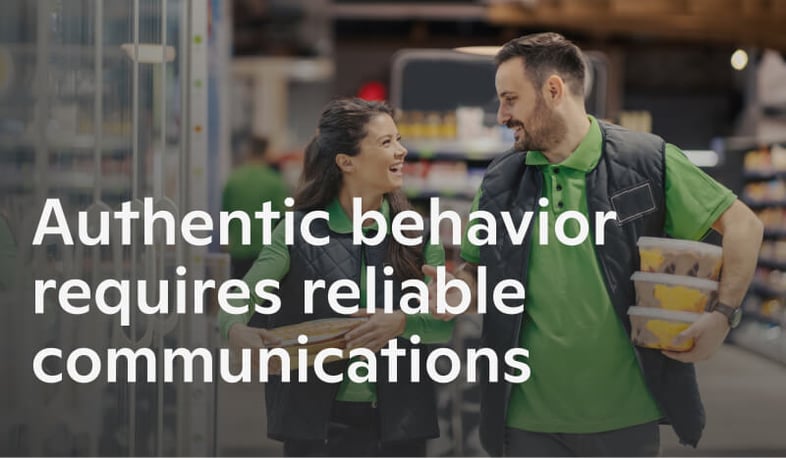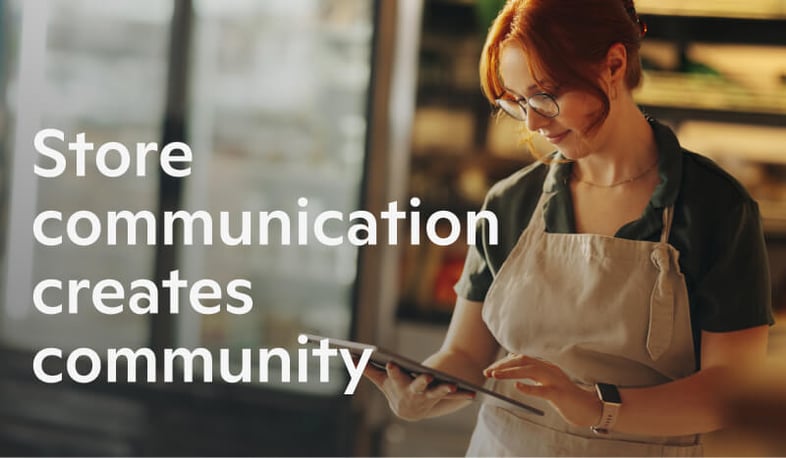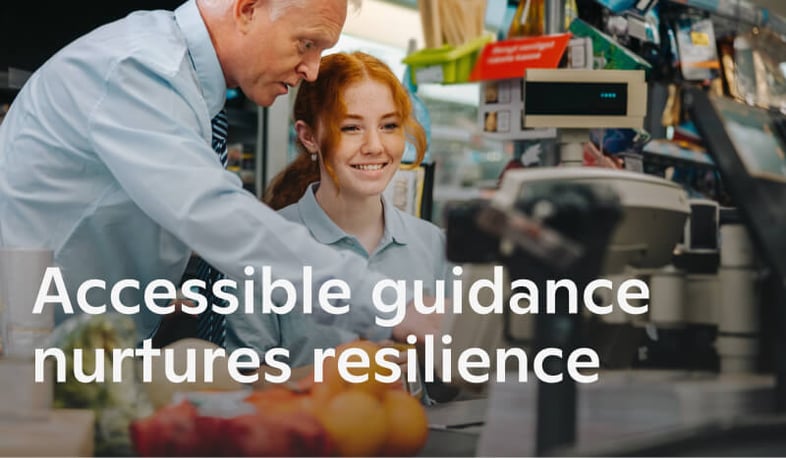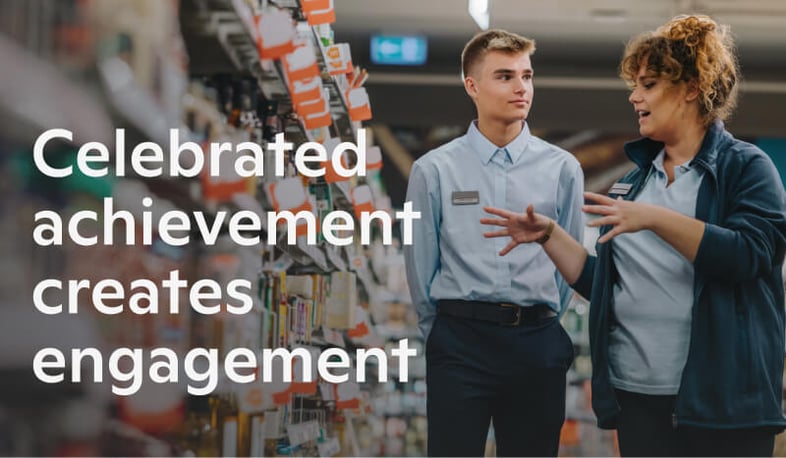Onboarding best practices, for grocers, are unappreciated art. Any supermarket worth its salt shelf should try to master onboarding if they want to crack the dam of cash flow. Luckily for you, we happen to be industry experts. We have prepared a list of the best practices supermarkets should follow to help hires achieve lasting success - while raising their retention rates.
Let's face it: grocery retailer retention rates are at the break point.
The Food Retailing Industry Speaks 2022 report’, lays this out in full. But despite its mouthful title, its findings are even tougher to chew. For, in 21’, the global turnover rate for food retail staff peaked at 48%. (1)
This grim figure has hardly dipped since then. Supermarkets, and employee turnover, might as well be synonyms.
The aftermath of that statistic haunts the hiring process. The talent pool is taking notice, for hires that hear tales of high churn make the obvious (if incorrect) conclusion that a role in groceries offers zero career mobility.
This dynamic is not made better by uninspired grocers barely putting effort into improving onboarding. The predictable result is that their churn rates remain high. (2) This is less a chicken-egg situation than a full-blown egg spillage on isle three.
But the competitive companies are starting to cotton on. Many employers are now investing in the experiences of new hires.
For example, Kroger; the second largest supermarket in the US - and one of the largest private companies in the world - took the leap. (3) Kroger invested millions into improving their new hire experience through 2022.
This is despite the US labor market standing stronger than other markets - such as Europe, which is suffering a hire shortage. Kroger did not need to invest in improving the experiences of their hires, yet they did anyway. This sheds some light on the value of onboarding for fast-moving grocers.
You could even claim Supermarket onboarding is invaluable. Onboarding best practices prime employees for success from the moment they step through the automatic doors – as it sets the tone for a hire’s ability to tolerate future changes – a vital skill for any long-term career with evolving responsibilities.
Remember, onboarding is an immediate, harsh routine change in and of itself. By making the “reality shock” (4) of entering a new role as fluid as possible, new hires gain vital experience that will be put to effective use adapting to future shocks as they progress into their first year of work.
That first-year matters – for it is the first year that contributes the most to an employee’s churn likelihood. Here are, reliable five tips on how to get hires started with their best foot forward:
STEP 1: Your hires are unproductively pretending. Help them feel authentic.
Build the framework for lasting trust
The Problem:
Problematically, many grocers do not have a formal plan for community building when they onboard new hires. Instead, employers expect team leaders to connect with hires on their own, in parallel to training them. That approach is like expecting the freezer to keep the beef cold, without checking if it is plugged in the wall. Remember, a hire’s willingness to work hinges on how well their employer supports workplace. (5)
Supporting trust is vital for success. This is the stance of industry experts, who claim new hires are ‘pretending.’(6) The phrase, ‘fake it till you make it’ is famous for a reason. All data shows hires are improvising for the first months of their job. Their workflow will grow and change once they get comfortable with their position. Think of it this way: according to data, new hires take eight months to a year to achieve peak productivity. By equipping hires with communications tools to remove ambiguities in their learning process, a hire can work authentically, quicker.
The Best Practice:
One practice that is a candidate for the best of the best, is to attach onboarding lessons to a feedback system. An implementation that is proven to work is to digitalize onboarding guidance into a sequence of interactive modules. At the end of each module, new hires undertake a quiz, showing what they have learnt, and why. This arms managers with an earnest overview of a hire’s current progress – which lessons they have taken in, and why. These insights are invaluable, allowing for informed talent management.

This system does not only help managers gain an authentic overview of the onboarding process – it also helps the hire. A digital training app gives employees receive a frank ranking of learning outcomes. Which skills they mastered, and which they need to revisit, are clear. This aligns both managers and employees, allowing hires to figure out their competencies quicker. It is a simple calculus – hires who are aligned earlier reach peak employee productivity, up to two months quicker, than those who aren't. (5)
STEP 2: Turn hires into a close-nit team with two-way communications.
Transform your stores into communities
The Problem:
People are tribal. From team sports to the morning shift; having an in-group is fundamental for fitting in. Studies consistently find that at least 51% of employee retention work is tied to belonging - and that is just what can be tested for. (7) The indirect benefits include elevating an employee’s ambition, work ethic, and desire to up-skill.
Workplace culture, shaped both in the store, and in the backroom, is hybrid. It is shaped in cyberspace and through face-to-face interaction - what your employees say, think, and believe.
Onboarding is not only the process of joining a company as a passive passenger, but also a journey as one of the legs. Like crew in a rowboat, team relationships, workflow, and interactions with one-another evolve when new people join them. If this process isn’t handled well - proverbially rocking the boat - hires could feel that sinking feeling.
Our data says supermarkets are undervaluing teamwork, and its role in defining an employee’s value system. New hires want to feel connected to their workplace community. This includes both their coworkers, and their manager – in a common information space as the rest of the company. As a result, we can confidently state that any supermarket that does not prioritize teambuilding suffers from a poor internal communication strategy.
The best practice:
It is self-evident that to work brilliantly, you need to feel brilliant. An employee’s opinion of their team, and their job, is decided by their first impressions - and by their team’s reactions to them. Onboarding software should thus show the company positively. Through candid identification with the culture, the culture’s goals - and that your work is furthering those goals.
Two-way communication is an excellent way to ensure that new hires feel a connection with their immediate manager. The benefits are equally two-way, for managers and team-members glean insight into the hire, the better they adapt to their needs. Remember, it is impossible for a manager to overcommunicate with their hires – deeper communication is always valued by hires. (8)
A workplace app with two-way communication functions guarantees that hires are never far away from the advice and feedback of a team-member, or manager. This freedom lowers stress levels, while increasing the likelihood that the team will bond together. As a result, a close-kit team is vital for both employee engagement and reducing employee turnover – for you cannot have a functional workforce without clear, uncomplicated, communication.

STEP 3: Nurture upskilling and voluntary training, at any time, all the time.
Arm hires with initiative
The Problem:
Grocery work is a schedule of peaks and troughs. No two shifts are the same, and, while activity hours can be predicted in broad swathes, there is always uncertainty. The side-effect is that there will be periods of relative inactivity and unstructured time - especially at the back to the store.
Most people want to learn. People need change - and, despite popsci’ opinion, adults are keen trainees. Moreover, they are keen learners throughout their entire careers. Thus, the word no hire wants to tie to their day is ‘repetitive’. Hires want a training program that adapts to them - and nobody will feel motivated by an onboarding schedule that feels like a prison day plan.

Boredom is not a response to getting work done - but a lack of control. (9) Research shows that staff who feel their training lacks meaningful structure suffer elevated stress. Therefore, an onboarding program that isn't a snooze-fest should seek to give hires the initiative over when and how they train.
The Best Practice:
Guidance, instruction, and structure must be accessible to be successful. Often a new hire will need access to training materials during a shift. But a new hire cannot carry around a guidebook while talking to a customer, or when stacking a shelf. Not only would it appear unprofessional – it would physically get in the way.
Fortunately, the same guidance can be presented in a format that is both professional and accessible. A digital training app can be leafed through on the go - from an ever-available portal on an employee’s mobile phone. With such a system, momentary procedural missteps can be researched by an employee, without calling a manager.
A digital guide is flexible - since it enables employees to learn about the company, its policies, and procedures at their own pace. This is great for pre-boarding employees – since they can begin their training and development before they walk in the door.
A good solution to this problem is to make guidebooks accessible on mobile phones – via a digital onboarding system. (9) Not only does this system save on printing costs, but it also means that a new hire can start learning procedure before their first shift starts.
STEP 4: Empower hires by inspiring them with high achieving employees
Inspire competitions, crown champions
The Problem:
Workplace blogs that do not know what they are talking about fill lines with dated concepts. The worst offender among them is Maslow’s Hierarchy of needs - AKA, the fulfillment triangle. Quite apart from being an unscientific concept of questionable merit, it ignores a critical factor of hire motivation; competition.
Let’s place that triangle to one side and face the real story. Employees want to feel effective (11), and, as a result, useful to the organization - that their service or mentality is desirably unique. So, a good employer allows individuality to shine by amplifying individual successes. This raises the personal expectations of the hire's entire team.
Part of social media’s latent reach is how effectively their platforms celebrate the user. Nothing is ignored – from accomplishments to personality traits. Such celebrations give their audience meaning by affirming them. This tells them that their efforts bear progress - that their journey has had a positive result - both for the company, and for themselves.
The Best Practice:
Any onboarding program worth the bytes it is written with celebrates the achievements of the wider workforce. Often the productivity of hires is determined by what they view as the standards and expectations of the workplace. As a result, the best way to motivate champion hires is to lead by example; to inspire them to match, or exceed, the achievements of their coworkers.

Thus, a good onboarding that follows best practices connects hires with company socials and news. For example, if a store succeeded with an initiative or sale, then that success should be shared. This local victory becomes a victory for the entire organization, when shared on workplace media. This can motivate entire teams across the organization to emulate their victory.
Emoji and commentary reactions are great for peer feedback, as they encourage dialogue between staff members. As Tanner notes, “Symbolism, in the workplace, is still fractured” (11)- often, employees feel that the iconography of their employer is detached from their workday – and their real coworkers. Aligning all three factors together with a branded onboarding platform, that celebrates worker achievements, goes a long way to solving this dilemma.
Creating a digital record of successful tasks is highly motivating for new hires. An onboarding checklist, for example, will act as a series of motivational milestones. Completing each task on the list reminds new hires of each victory they accomplish in any given day.
STEP 5: Gamify onboarding to stimulate staff motivation
Kick Boredom in the Ennui
The Problem:
On the internet, inspiring hires is a well-worn territory. You will find self-claimed ‘guidance’ on a range of pages which, to be frank, parrot each other. They will repeat the same points - covering the big-picture values of onboarding, without telling you anything you did not know already. They do not address a major symptom of poor onboarding; employee boredom. (12)
Classically, grocery retail only gives hires around eight hours of training. This is a catastrophe, since it means half of employee churn occurs within the period of onboarding. Furthermore, that is only the average - there are supermarkets and grocers out there who have far worse rates. The result is ennui - a feeling of dissatisfaction arising from a lack of excitement.
Your new hires are brand-ambassadors. This is especially true in checkout positions, where new retail employees often start their roles. In this position, hires wear their enthusiasm on their sleeves. If they feel badly adjusted, customers will notice - remember, a grim attitude is infectious.
The Best Practice:
The key to stopping boredom is giving employees a sense of strategy - and a way to achieve this is by structuring into your onboarding program context on how and why their role is valuable. Remember, hires, especially the young hires who fill most grocery positions, are more likely to feel ideologically engaged - and, therefore, motivated - when they are reminded why their work matters. (12)

For example, a critical factor to how employees perceive a company is immersion. Onboarding usually contains role-agnostic lessons, such as workplace safety information. Studying such courses can feel one-size-fits all – too generified for intuitive learning. However, by branding training modules with a store's logos, colors, and themes, training feels less detached, and better connected to the individualized workday of each hire.
Classical print guidebooks are an informational paradox: they need to be both comprehensive, and easy to read. Digital onboarding makes this problem an easy fix, by distilling all information usually found in a print guide into short, multimedia training programs.
Bite-size courses are engaging. They can even be used as e-learning games through frequent, automated, small tests, delivered at the end of every module. This strategy is called gamification, and its advantages are well known. (13) Small bursts of learning, tested often, stick in hires' heads.
Small modules also allow for signs of progress. Certifications, or point-scores, help new hires build esteem. This results in onboarding feeling like a progression, not a slog - with frequent, positive reminders of the hire’s progress and success.
Sources
Food Industry Speaks 2021 report, by FMI, (1)
Toxic culture is driving the Great Resignation, paper by MITSloan, Management Review (2)
Kroger (3)
Reality Shock in the first year of work (4)
Onboarding: Getting New Hires off to a Flying Start by Christian Harpelund, Page 34 (5)
Pretending – Gallup, Clifton Review (6)
OC tanner global workplace culture report, page 17 (7)
Academy of Management Journal In-Press Communication Miscalibration: The Price Leaders Pay for Not Sharing Enough (8)
Exploring Digital Onboarding for Employees (9)
OC tanner global workplace culture report, page 11 (10)
How do you Measure the Impact of Effective Onboarding Practices? (11)
The Progressive Grocer (12)
Gamification (13)
Contains discreet data and assertions sourced from Relesys


-Jan-17-2023-01-17-53-1140-PM.jpeg)


